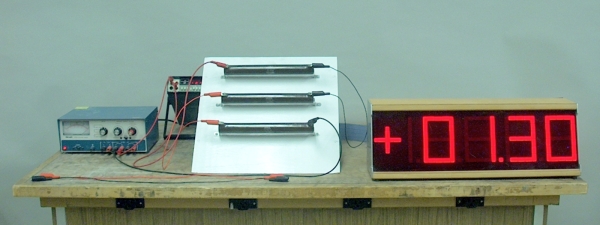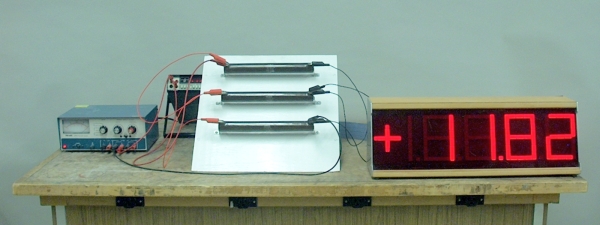

Three large 5,000-ohm resistors are mounted on the board in the center of the photographs above. At maximum, the power supply (at left) produces 20 volts. The positive side of the power supply is connected through the ammeter next to it to one of the resistors. (The ammeter is also connected to the large display at right.) You can use the clip leads to connect the resistors entirely in series, as shown in the top photograph, or all in parallel, as in the bottom photograph. You can, of course, start with a single resistor in the circuit, then add a second either in series or in parallel, and you can put one in series with two in parallel.
This demonstration allows you to illustrate Ohms law, V = iR, and to show that the resistances of resistors in series add linearly (i.e., R1 + R2 + R3 = RTotal), and for resistors in parallel they add reciprocally (i.e., 1/R1 + 1/R2 + 1/R3 = 1/RTotal). This is because when the resistors are in series, any current passing through one resistor must pass through the others as well, and each resistor develops across itself a potential difference that is proportional to its resistance. The potential differences across the resistors add linearly, i.e., iR1 + iR2 + iR3 = VTotal, and i(R1 + R2 + R3) = iRTotal. When one places two or more resistors in parallel, the potential difference across each resistor is the same, but the current splits between (or among) them in inverse proportion to their resistances. Thus, i1 = V/R1, i2 = V/R2 and i3 = V/R3, and iTotal = V(1/R1 + 1/R2 + 1 /R3). Since iTotal = V/RTotal, 1/R1 + 1/R2 + 1/R3 = 1/RTotal.
The current through a single resistor should be 20 V/5,000 ohms = 4 mA. Through two in series, the current is 20/10,000 = 2 mA, and through three in series, the current is 20/15,000 = 1.3 mA.
In parallel, two resistors would give 20 V/2,500 ohms = 8 mA, and three would give 20 V/1,667 ohms = 12 mA.
So in series, adding resistors reduces the current by the proportion of the added resistance to the total resistance, and in parallel, adding resistors increases the current by the amount the added resistance alone would draw.
The combination of one resistor in series with two in parallel would draw 20 V/(5,000 + 1/((1/5000) + (1/5000))), or 20 V/(5,000 + 1/(4.0 × 10-4)), or 20 V/(5,000 + 2,500) ohms = 20 V/7,500 ohms = 2.7 mA.